#Petit Picpus
Text
OK I’m going to try to analyze this, but my knowledge of convents in 19th-century France is even less than my knowledge of Waterloo:
This convent is definitely among the harshest possible. I think this paragraph sums it up well:
“The Bernardines-Benedictines of this obedience fast all the year round, abstain from meat, fast in Lent and on many other days which are peculiar to them, rise from their first sleep, from one to three o’clock in the morning, to read their breviary and chant matins, sleep in all seasons between serge sheets and on straw, make no use of the bath, never light a fire, scourge themselves every Friday, observe the rule of silence, speak to each other only during the recreation hours, which are very brief, and wear drugget chemises for six months in the year, from September 14th, which is the Exaltation of the Holy Cross, until Easter. These six months are a modification: the rule says all the year, but this drugget chemise, intolerable in the heat of summer, produced fevers and nervous spasms. The use of it had to be restricted. Even with this palliation, when the nuns put on this chemise on the 14th of September, they suffer from fever for three or four days. Obedience, poverty, chastity, perseverance in their seclusion,—these are their vows, which the rule greatly aggravates.”
The only time a modification for “comfort” is made is when the nuns risk death if they don’t alter it, highlighting the extent to which they deprive themselves of any comforts (bordering on depriving themselves of necessities - never lighting a fire could be dangerous in winter).
On the bright side, they hold elections! Their elections are very limited (only the mères vocales vote), but it’s something! However, given Hugo’s emphasis on men in this chapter (the man who founded this place, the officiating priest, etc), it’s unclear how much influence over decision-making they actually have. This looks democratic, but in reality, it can’t be considered a great democratic system with how limited the vote is and with the difficulties of asking for information. It feels oddly similar to the Restoration; there’s a veneer of change and interest in “reform” there, but the government is still very distant from the people and is inaccessible to them, just as these votes give the impression that the nuns have much more say in the convent than they likely do. This parallel is underscored by the “absolutism” of the prioress, as the other women are expected to practice “absolute” submission to her.
Their constant repentance for sins is likely meant to be read as extreme and/or intense, but it’s also quite fitting for Jean Valjean, who shares this mindset of needing to constantly repent for his supposed “sins.” Of course, we as the reader know how trivial these “sins” are and how much good he’s done, but he still devalues himself in an explicitly religious light (as after the bishop, Catholicism has framed many of his mindsets). The self-abnegation and punishment Valjean and these women inflict on themselves stands in sharp contrast to the welcoming, optimistic Catholicism of the bishop.
The nuns, though, are even more extreme than Jean Valjean, as they pray for all the guilty. However, they’re also in a religious institution, so to an extent, it makes sense that they would take greater responsibility for sins (including the sins of others).
Others have mentioned how Valjean’s focus on Cosette’s privacy in the Gorbeau House reflects his lack of that while in prison. This convent, then, is like a prison. The women do not have rooms to themselves, are not allowed to form attachments, and are encouraged to lose their sense of self. Again, there’s the possibility this was voluntary (although women could also be sent to convents by relatives or other means), so it’s not exactly the same, but the parallel is chilling. They can’t even communicate with family members in several cases, just like Valjean was separated from his family in prison. Another commonality is that the women are punished severely for the smallest infractions, like a broken glass or a torn veil, just as Valjean’s been condemned for life for stealing bread.
I love that the nuns are all very bitter about their conflict with the government over burials. Maybe they’re not supposed to have many individual opinions, but they can collectively insult the government together.
42 notes
·
View notes
Text
Icl the almost-getting-buried-alive sequence in petit-picpus where they have this complete heist-like plan and it seems like it's all gonna work out perfectly and then they show up and it's a WHOLE DIFFERENT GUY and Fauchelevant literally has to claw jvj out of the ground later to check if he's alive is soap-opera level dramatic and the most intense thing I've ever read. No competition.
#les miserables#victor hugo should write soaps#Fauchelevant literally opens the coffin and does a full romeo assuming hes dead and despairing#the graveyard bit#Petit picpus#booklr#jean valjean#victor hugo#les mis#les misposting
14 notes
·
View notes
Text

Literally that's what Cosette sometimes does in her convent school days
The nuns all knew that several of their students are severely traumatized one way or another
So they just let those girls do quiet anxiety relieving stuff as long as it isn't harmful and doesn't disrupt the class
Those girls are grateful for that and sometimes doodle or knit in classes
#ptsd#convent school girls#convent school#petit picpus#les miserables#les mis hcs#yes cosette is THAT traumatized give her a break pls
6 notes
·
View notes
Text
my fellow brick readers, i have a question. what was your least favorite book(s) to read in the whole thing.
#for me it was/is petit-picpus#and parenthesis#idk man i hated the learning about catholics and nuns#i dragged myself through reading it#les mis#les miserables#les misérables#EDIT: GUYS YOU MADE ME REMEMBER ARGOT#fully last time i read the brick i remember skipping the whole section#apologies to any brick purists who disagree with skipping sections#but i was a high schooler with low tolerance#anyways amending my answer to also include argot
55 notes
·
View notes
Text
"The one where I decided to play Victor Hugo"
Y'know, I truly wanted to see an adaptation of Les Misérables set in some Latin American country, and also in a more modern setting.
Yes, I know that some elements of the original novel could probably be lost due to the change in time period (and place), but at least there would be a HUGE chance of seeing little Euphrasie "Cosette" Fauchelevent wearing school clothes that looked like these:


(In case you're curious, these pictures are from two Mexican soap operas, "Gotita de Amor" and "Carita de Àngel")
And don't even get me started on the First Communion dresses.


(I don't know for sure if this applies to all Latin American countries, but I know it was a common occurrence until some point – especially during the late 19th and 20th century)
And while we're on the subject, allow me to give you a little piece of history:
So, the school I attended as a child was originally designed to be a school for girls and young women only. A "single-gender school", if you will.
Here is a short excerpt from a local news report about the school:
"On July 21, 1903, eight Benedictine Sisters arrived in Olinda, Pernambuco [...] They were invited to help in the future mission in the Amazon region. As this mission took a long time to be carried out, the sisters found another field of apostolate: in the catechesis and education of youth."
From the beginning, the Benedictine Sisters have dedicated themselves to the education of young people and women above all else. Schools have been established in the places where they have settled. Thus, throughout their history, many types of educational institutions have emerged [...] including a College in Olinda and a Conservatory of Music in Manila. In the Philippines, the Sisters run 25 schools belonging to the Congregation, with approximately 30.000 students. In addition to these educational institutions, there are other educational institutions, such as: Household Schools, Dressmaking Courses, Schools for the Disabled, Nursing Schools and Bible Schools. In addition, courses of all kinds are offered to meet the specific needs of people."
YES, THE BENEDICTINE SISTERS ARE BACK EVERYONE
Normally, schools of this type, in this case, those that were "single-gender", were private – requiring a certain amount of money to be paid each month. But for students who came from poorer families, it was possible to get a scholarship.
I don't know much about this information, but apparently there were some rooms available within the school property, where students could stay overnight during the week. This was because e some of the students lived in places that were far from the city (in rural areas for example) and this made it difficult for them to have to travel every day to attend classes.
Since that was where the nuns lived, they had no problems regarding food, comfort or safety of the students either.
And, of course, no boys were allowed
The uniforms, as you will see in the images below, consisted in:
Long-sleeved white blouses. But there were also short-sleeved blouses for outdoor activities.
Long, dark blue pleated skirts with suspenders;
White socks;
Black shoes;
White gloves and a dark blue beret – which matched the tone of the skirts.


I had one of those by the way, but we didn't use it on a daily basis, only on special school occasions: like church, the school anniversary and marching band parades.
Unfortunately (or not), by the time I attended the school, many of the original traditions had been lost over time. The nuns were no longer responsible for teaching the classes – but they still lived on the school property, three of them more specifically. Both girls and boys could study at the school, and our curriculum was no longer the same.
Now, imagine my shock when I discovered that my aunt, her sisters and friends (who also attended this school) used to have French lessons. They even learned how to sing the French national anthem...
I was a little jealous of them, to be honest 😭
#les misérables#les mis adaptations#victor hugo#cosette fauchelevent#les misérables petit picpus#the brick#les mis#les mis brazil
2 notes
·
View notes
Text
889 pages after the waterloo digression and he gives you this look:
Qu'on nous permette de recourir, pour la clarté du récit, au moyen simple déjà employé par nous pour Waterloo. (t. II, IV, 12, I, p. 438)
uh-oh. don't do it vicky! we just had 26 pages on the historical day 5 june 1832, we don't need another waterloo (70-page play-by-play commentary on a historical event in which our characters barely feature) on top of that!
Les personnes qui voudront se représenter d'une manière assez exacte les pâtés de maisons qui se dressaient à cette époque près la pointe Saint-Eustache, à l'angle nord-est des halles de Paris, où est aujourd'hui l'embouchure de la rue Rambuteau, n'ont qu'à se figurer, touchant la rue Saint-Denis par le sommet et par la base les halles, une N dont les deux jambages verticaux seraient la rue de la Grande-Truanderie et la rue de la Chanvrerie et dont la rue de la Petite-Truanderie ferait le jambage transversal. (ibid., pp. 438-439)
oh, so it was just a reference to his method of describing the relative locations of a bunch of streets by comparing them to a capital letter of the alphabet.
saying this, she casually threw a large cobblestone at la garde municipale.
#actually the last time he did this was when he was describing the streets around the convent. which was after waterloo#he loves using this device which is great for me because it actually helps!!! usually when i read written descriptions of relative#locations in space it does nothing for me. but apparently taking a bird's-eye view and tracing a giant letter over the top is#the secret sauce#the battlefield of waterloo was an A and the streets around the convent were a Y and now the streets around this barricade are an N#interesting that this time it's an N since usually in this book when he talks about the letter N he's talking about napoleon#maybe that's why he's specifically referencing his description of waterloo rather than his description of petit-picpus#les mis#lm 4.12.1#my posts#f#unfortunately while i do think i understand the location of these three streets and possibly how they relate to la rue Saint-Denis#i don't really understand where les halles are in all of this. and then he brings la rue du Cygne and la rue des Prêcheurs into it#and i'm like stop stop that's too many streets!!!#like i thought saint-denis was at the top of the N running perpendicular and les halles were doing the same thing at the bottom?#but then sometimes it sounds like les halles are on la rue saint-denis?#no wait i just reread that part and i think he's saying if you leave la rue saint-denis via la rue de la Chanvrerie eventually you will get#to les halles. so yeah they're on opposite sides of the N. still don't know what's up with la rue du cygne and la rue des prêcheurs though
5 notes
·
View notes
Text
It’s fascinating how Jean Valjean is constantly associated with imagery of being buried alive.
His literal near-burial in the coffin outside Petit-Picpus is the most obvious example of that. But it’s in the sewers chapters as well— he has to face the horror of nearly drowning and being buried alive deep underground in the filth beneath the city.
And that imagery a running motif throughout his entire storyline. His imprisonment is constantly compared to as a burial, a living death; being in prison is like being trapped and drowned underneath an enormous weight, unable to move, unable to escape, with everyone around you refusing to acknowledge you are still a living human being.
In his dream before the Champmatheiu trial, Jean Valjean had a nightmare where he’s surrounded by a faceless crowd of indifferent people, who tell him:
‘Do you not know that you have been dead this long time?’
I opened my mouth to reply, and I perceived that there was no one near me.
The core horror of Jean Valjean’s plotline is the horror of being buried alive. It’s the horror of being constantly told that he is dead when he’s still living and suffering and desperately struggling to escape—- but suffering alone while he’s buried in a place so deep that no one can hear him.
#what I’m saying is that in the Magnus Archives …Jean Valjean is an avatar of The Buried#Javert is obviously the Hunt#les mis#les mis letters#relevant to the sewer chapters#lm 5.3.7#lm 2.8.7#lm 1.5.7#lm 1.5.8#buried alive
221 notes
·
View notes
Note
yooo you wanna draw valjean doing gardenwork while at petit-picpus (or like anywhere? rue plumet would prolly be neat too). i hope this is enough information. uhm. hes probably gonna be wearing a large straw hat too

here you go bestie pal amigo friend buddy bestie pal
as for the straw hat……
it uh. blew off his head (I TOTALLY DIDNT FORGET IT)
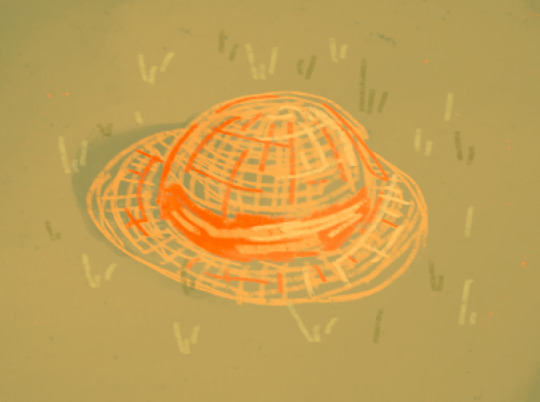
btw guys this was the post asking for requests. rn i probably wont do any but yall are always free to ask! (animation requests could be fun too!)
#art requests#les mis#my art#my animation#jean valjean#cosette fauchelevent#<- technically#it took a while BUT#this was fun :]#i haven’t actually animated in a while so this was great!! helped me get more comfortable with the program as well :]]#now idk how good this actually is but yeah 👍#(im not good at drawing backgrounds 💀)
55 notes
·
View notes
Text
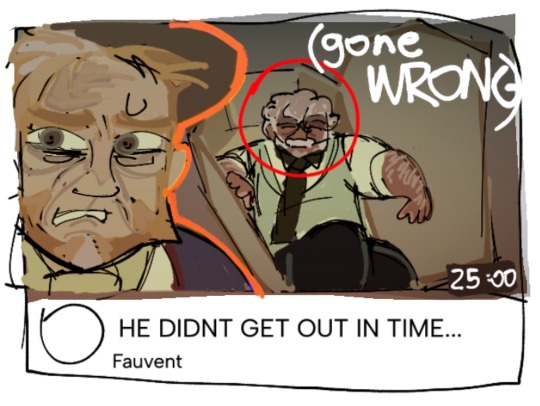
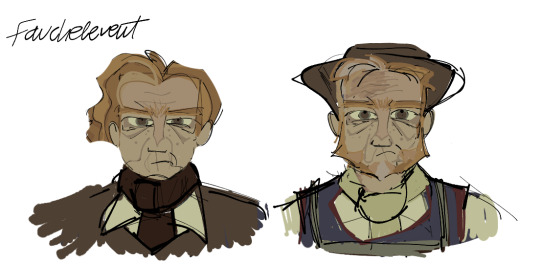
(repost) fauchelevent is underrated tbh . wish there was more fanart of the petit-picpus era characters :p
#the coffin heist always gave off “mrbeast youtube video” plot tbh😭😭#fauchelevent#jean valjean#les mis#les mis fanart#ultime fauchelevent#character design
140 notes
·
View notes
Text
Congratulations, Les Mis Letters readers, on finishing Volume 2: Cosette! 🎊
A wild journey from Waterloo, to the ship Orion, to Montfermil, to the Gorbeau House in Paris, and finally to the Petit Picpus convent and a wacky coffin heist.
On to Volume 3!
45 notes
·
View notes
Text
I present to you Les Miserables was stolen!, a 2003 French comic which "recounts a fictional and dramatic episode in the life of Victor Hugo."

It begins with Victor's publisher Lacroix arriving in Guernesey, where Victor lives in exile, surveilled by agents of Napoleon III. Note that he has no beard.

Everyday Victor follows the same routine while he finishes writing Les Miserables. Hmm....
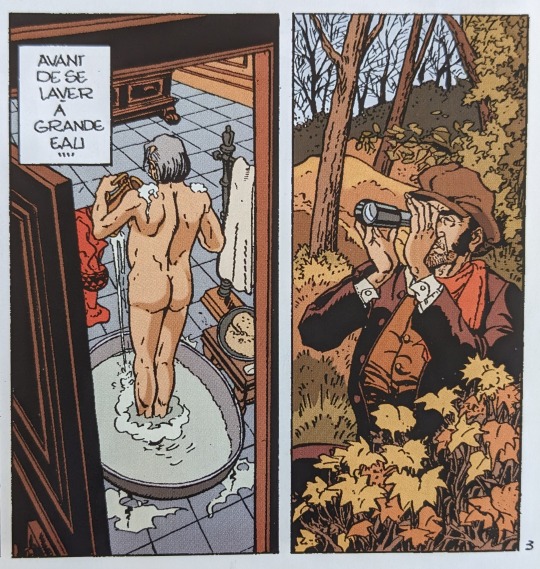
Tragedy strikes! He finds that his manuscript has been stolen! He rushes to Juliette Drouet's house and they discuss what could have happened.

Could it have been someone with a personal vendetta? Or Napoleon III's secret police trying to surpress a revolutionnary text? Victor decides his only solution is to go to Paris and try and track down the thief. 'No' says Juliette, 'you'll be arrested!' But Victor has a disguise.

Now with a beard, he heads to Paris where he enlists the help of his friends: Adele Hugo, Dumas, Lamartine, and Sainte-Beuve ("although he is my wife's lover, he is not necessarily my enemy").
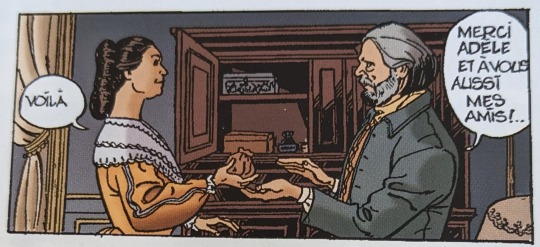
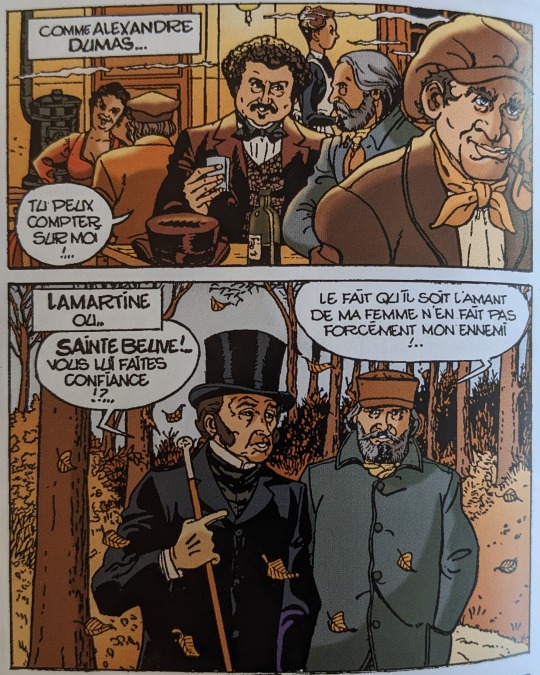
He needs a place to stay that no one will suspect so he goes in search of a woman he once helped.
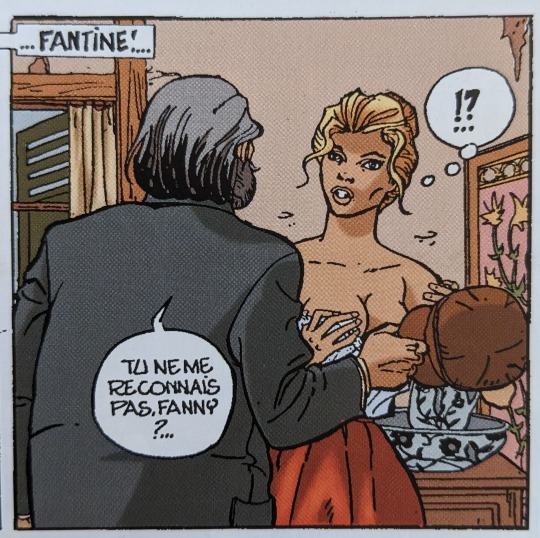
She is a sex worker named Fanny Fantin, the inspiration for the character Fantine -___- and she agrees to help him. A strange man comes around and starts asking for "Fantine." Victor concludes that whoever stole his manuscript, knowing that he had drawn inspiration from real life, is looking for "Fantine" in order to find him. (Don't think about the plot too hard.) Victor bribes Fanny's pimp to track down the man and Fanny lures him to her room where Victor is waiting. A struggle ensues.
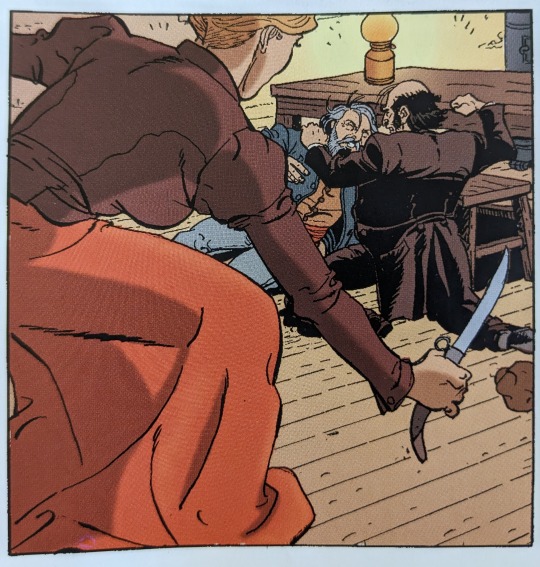
Fanny kills the man, saving Victor but they lose their lead. What's more, her scream attracts the attention of the police. Victor tells her to follow him onto the roof so that they can escape.

As Fanny lays dying on the sidewalk, a gamin named P'tit Louis, who is friend of Fanny's, tells Victor to run but Victor cannot resist saying some final words to Fanny, who is surrounded by onlookers and police. He promises he will take care of her daughter. Her daughter? Yes. Victor was surprised to learn that she has a daughter who she had left in the care of a suspicious couple. Victor's words were so eloquent that as he walks away, something clicks in the mind of a police man, who had heard rumors that a certain author was in town.

wtf is he wearing!! Anyways, Victor runs away. He gets a tip from the pimp that Hetzel, his old publisher, might have been trying to buy the manuscript off the murdered man so he and Dumas investigate.

This is a dead end. They then go to retrieve Fanny's daughter, Sylvie. Victor pays off the couple who were keeping her.

Victor wonders where he and Sylvie can hide. He tells Dumas that he thinks the thief will continue to track him via the plot of his novel so he decides he will go to the Petit-Picpus convent to try and catch the thief. The Picpus convent is a real place where ten years earlier Victor had been allowed to study their customs. The mother superior is reluctant to let them stay but when Victor reminds her of the isolated gardener's shack, she agrees. However!

Who should arrive but Sainte-Beuve, asking if Victor is hiding there. The mother superior won't say anything. Sainte-Beuve tells her that Victor is wanted for murder (because of the man Fanny killed). The mother superior tells Sylvie to fetch Victor.

Victor wants to know how Sainte-Beuve knew where to find him. Sainte-Beuve says that Dumas told him, before leaving for Italy (that's it, Dumas isn't in the story anymore.) 'Hmm okay seems reasonable' says Victor. Sainte-Beuve leaves. 'That was curious,' says the mother superior. 'When he saw Sylvie, he called her Cosette!' Hmmm...
Cut to P'tit Louis. The pimp, the Thenardier equivalent character and their gang have tracked Victor to the convent and they want P'tit Louis to help them rob Victor, to avenge Fanny. However, P'tit Louis remembers that Fanny had once told him that not all bourgeoise are bad, for example, there is Victor Hugo.
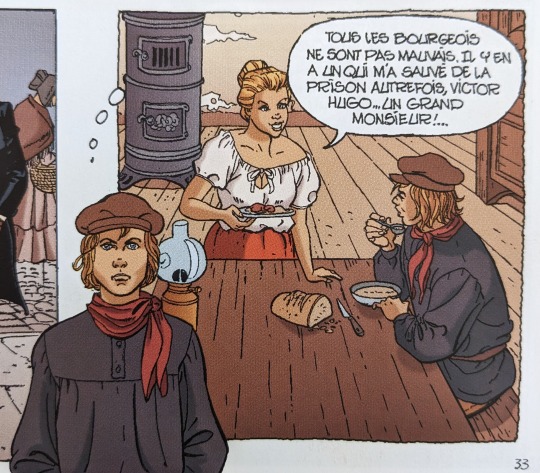
P'tit Louis tries to warn Victor but the nuns won't listen to him.

Meanwhile, the police also arrive in search of Victor.
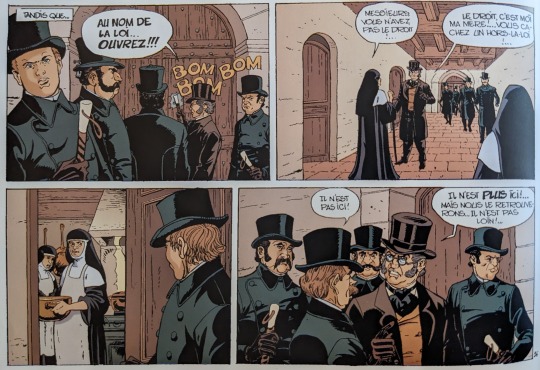
P'tit Louis jumps the convent wall and helps Victor and Sylvie escape by the sewer. However, the gang is waiting for them there! P'tit Louis helps them escape the gang too.
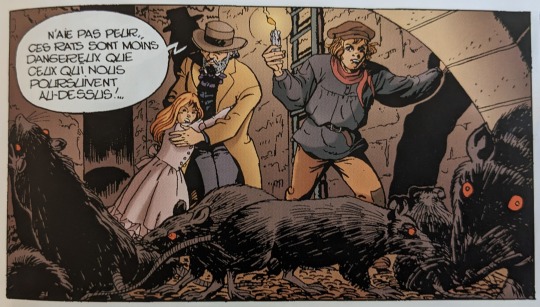
Victor and Sylvie take a carriage to Adele's house. Victor sees Adele leaving to go to Sainte-Beuve's. Victor follows her there and bursts in.
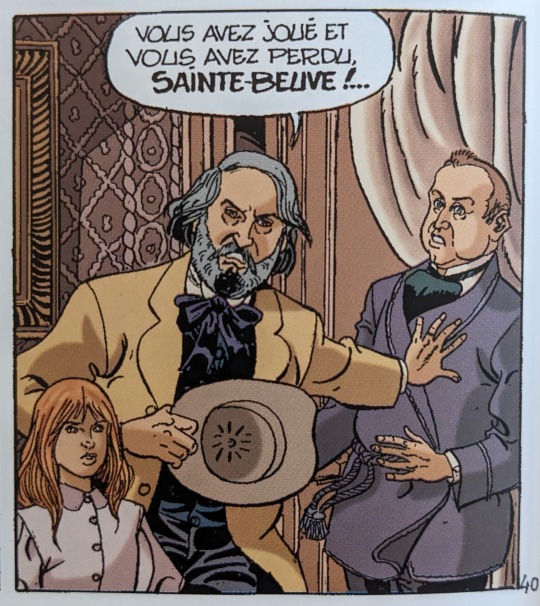
Victor starts tearing Sainte-Beuve's house apart. 'I know you have my manuscript,' he says. Only the person who stole the manuscript would have known the name "Cosette."

Adele can't believe that it is true. Sainte-Beuve hangs his head in shame. Victor is looking all over but he can't find it until...he notices that Sylvie is shivering. That's strange...why is it so cold in here!?
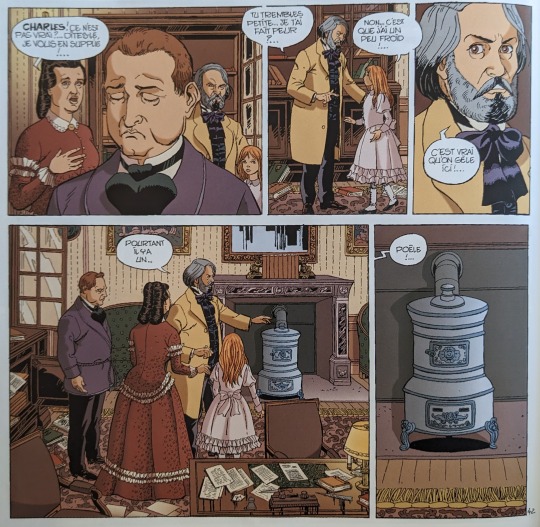
In the stove, Victor finds his manuscript.
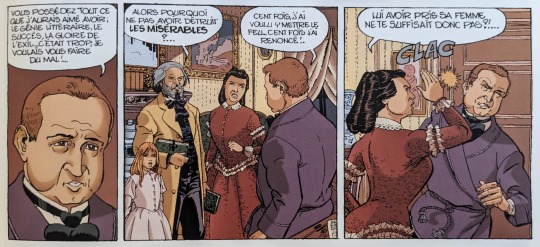
Sainte-Beuve explains that Victor had everything he wanted for himself and so he wanted to get revenge. He had tried to burn the manuscript but it was so beautiful, he could never bring himself to do it. 'It wasn't enough to have taken his wife?' asks Adele and she slaps him. At that moment, the police arrive and take Victor to jail. Meanwhile. . .

Napoleon III is informed of Victor's arrest but he orders that he be secretly returned to Guernesey to avoid a scandal. The police put Victor in a carriage. 'Where are we going,' asks Victor, 'why are we at Père-Lachaise?' They stop at a grave.

It's a tombstone for Fanny Fantin, the immortal Fantine of Les Miserables. Who could have done this? Sainte-Beuve emerges from the shadows. 'You can't image the disgust I have for myself. This tomb bears witness to a regret that will not leave me.' 'All men are condemned to live with their mistakes,' Victor tells him.
To wrap up, Adele and Victor try to convince P'tit Louis to come back with them but he wants to stay in Paris. Adele tells him to live at her house. The police officer tells Victor that he is just doing his duty by kicking him out of the country, but that he can't wait to read his book.
Victor and Adele arrive back in Guernesey with the manuscript and Sylvie. Juliette is waiting for them. 'What happened? Who is this?' Juliette asks. 'I'll explain everything,' says Adele. 'Now embrace me.'

They embrace. 'Who would believe it?' asks Victor's friend. 'It's not me but the theft of my manuscript that has brought them together,' says Victor. He learns that Napoleon III has just granted him amnesty. which he of course refuses. Fin!
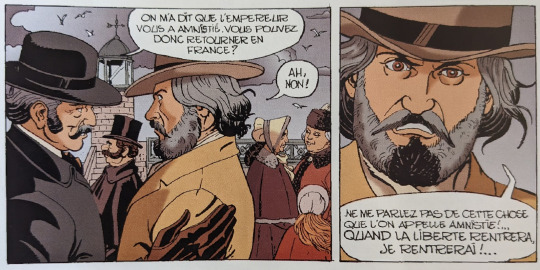
181 notes
·
View notes
Text
This line is so intriguing:
“The threshold smiled; the house prayed and wept.”
I think it does a lot to convey the weirdness of this place, which is at once holy and haunted, a shelter and a prison. The “smiling” threshold is welcoming, and it aligns well with the religious spaces we’ve encountered throughout the novel. While religious authorities are often suspect (Valjean’s shock that the bishop could be kind and a figure in the church is telling), religious spaces have consistently been a refuge. As Madeleine, Valjean went to church regularly to pray and help others (by consoling the grieving, for instance). And of course, the threshold of the bishop’s house is the most memorable welcome in the novel. At the same time, 62 Petit-Picpus isn’t happy in the way the bishop’s house was, with its prayer seeming to include a focus on sorrow or suffering (from the “weeping”) rather than on shared joy.
The descriptions of this place continue to be eerie, with Hugo including expressions like “if one dares” and emphasizing how empty and dark it is. Aside from the emotional barriers to passage, there are physical ones, like the grating and the shutters. On the one hand, the barriers inside challenge the welcoming image of the “threshold,” as if that welcome only extends so far. On the other, it makes this place even more menacing, since one can’t pass through it without constant monitoring and without a specific form of knowledge (like the passcode). The convent is obscure even to the narrator and to readers; it’s so isolated from the outside world that Hugo fears “transgressing” and trying to describe what “story-tellers have never seen.”
Even the light is uneven and ominous:
“The light which came from behind you was adjusted in such a manner that you saw her in the white, and she saw you in the black. This light was symbolical.”
Any outsider is shrouded in darkness and automatically condemned (”dark” = “bad” is a recurring image, especially when the light is connected to holiness). Hugo even tells us the light is symbolic (a funny aside, given how often his symbolism is very obvious, but also a clarification that this contrast between the “sinful” and “dark” outside world and the “holy, light” inside of the convent is intentional).
16 notes
·
View notes
Text




The More of the Petit-Picpus Convent. Volume 2, Book 5, Chapter 6.
Clips from <Il cuore di Cosette>.
21 notes
·
View notes
Text
Cosette and her religious upbringing
Cosette's beliefs of ' pacifist Rebellion against social injustices ' and strong Catholic faith also largely came from her religious upbringing in Petit Picpus Convent
The Petit Picpus Convent school is structured as a mix of a girls' orphanage ( all the primary school girls there are actually also orphans ) and a girls boarding school.....in a Convent run by nuns.
The educational programme in that school includes religious studies, culinary studies, visual arts ( which includes embroidery and pottery and several more ), several languages, etc.
School assemblies and masses are held in the convent prayer section, the convent school girls pray at every meal time and every night before they go to sleep, and often times, the school girls hang out at the convent gardens or the Convent school library in break times
Do not mistake such a disciplinary routine of the Petit Picpus Convent school girls for harshness. The nuns in general are all firm yet gentle with the girls, and offered much needed therapy and health care to those in need ( including Cosette, for starters ). Such disciplinary routines at the Convent school also helped build Cosette's strong catholic faith, and also her gentle and strong character



#cosette#les mis#petit picpus convent school#cosette is very religious#cosette is a devout catholic#petit picpus convent
9 notes
·
View notes
Text
The one, in which Valjean finds himself ensnared. But before that, he navigates instinctively through the fictional neighbourhood of the Petit-Picpus. Yes, this convent never existed, as hinted by Hugo: “Le Petit-Picpus, which, moreover, hardly ever had any existence.” Keep this in mind while delving into the convent digression. Hugo indulges in fantasy when describing the convent.
Meanwhile, Valjean's movements, in a desperate attempt to evade capture, echo his instinctive navigation through the sewers. There, as here, some paths lead to danger while others lead to freedom. Cosette's presence hinders him; though tired, she doesn't complain, simply walking slowly or sitting silently in his arms. He picks her up and sets her down as needed—a tender act from this caring old man (though it evokes the joke about a drug addict and a baby elephant.)
Then, Valjean realizes he's been trapped when he spots a black figure 'lying in wait for him' ahead. Javert is portrayed as devilishly predictive and knowledgeable about the labyrinth of Paris streets, somehow anticipating Valjean's route and positioning his men accordingly. Javert himself pursues Valjean, moving 'in the distant darkness.' Spooky! Valjean faces an impossible dilemma: 'to advance was to fall into this man’s hands; to retreat was to fling himself into Javert’s arms.' So, he simply raises his eyes towards heaven.
23 notes
·
View notes
Text
I want to draw the nuns in Montreuil-sur-Mer rolling their eyes at Sister Simplice cause she snitched on another nun for cutting corners at the hospital.
I want to draw the girls at the Petit Picpus convent running around and making their austere teachers smile with their pranks and naive beliefs.
I want to draw Fantine in her 40s meeting Marius and her finding it endearing how in love he is with Cosette, giving Valjean a goofy side eye cause she can how little he likes him.
I want to draw Eponine and Azelma in pretty 1830s dresses and Azelma with bright eyes while Jehan or Cosette or someone kind does her hair.
And I want to draw Eponine far from home, learning about a different city and discovering there’s more to life than misery.
I want to express in a visual style that the women in the book I care about are not born to be tragic.
TERFS DON’T INTERACT. FUCK YOU.
#Les Mis#les miserables#the brick#victor hugo#eponine thenardier#azelma thenardier#fantine les mis#cosette#I would draw all of this but I have the attention span of a gnat and I’m working on figure out my adhd and taking my meds daily#so maybe one day
26 notes
·
View notes